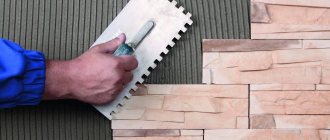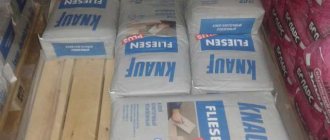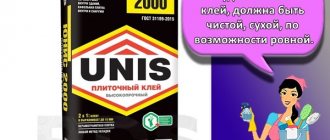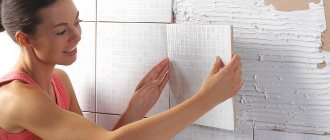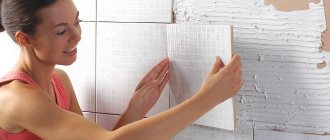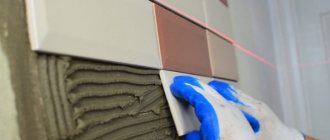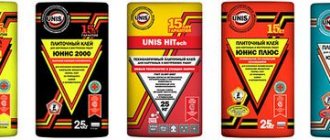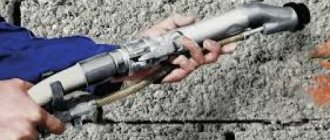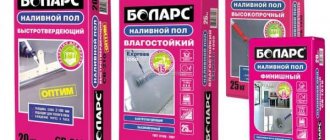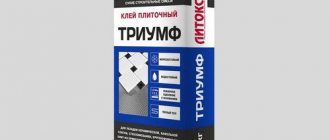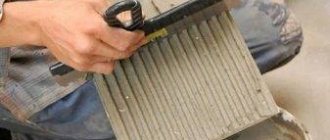Perhaps it’s worth starting with what tile adhesive is. Tile adhesive is a dry facing mixture created specifically for laying a whole range of different materials, such as:
- ceramic tile;
- porcelain stoneware;
- tile or mosaic tiles;
- natural as well as artificial facing stone.
A modern tile adhesive can be called Knauf Flizen adhesive, because Knauf Flizen tile adhesive is ideal for tiling your apartment or office at the highest level.
tile adhesive
Composition and properties
When choosing any building mixture for high-quality repairs, the consumer usually pays attention to its properties and chemical composition. The quality and durability of the finish will directly depend on this. The fact is that not all substances can contact each other and provide strong adhesion.
The presented tile adhesive is well suited for finishing both outside and inside a building, but it should not be used when tiling a floor with an integrated heating system. Otherwise, it is ideal, but requires certain conditions to be met for the repair to be durable. Able to withstand moderate physical stress and has high adhesion.
The tile adhesive in question is made on the basis of cement, mineral additives and water-repellent components that prevent water from penetrating into the thickness of the installation layer, protecting it from destruction.
There is also a special plasticizer that makes the finished solution elastic and pliable. Easily applied to the surface using a comb, grater or spatula.
Strengthened composition
The presented product for tiling walls and floors with tiles or porcelain stoneware is highly durable, so it is recommended by specialists when installing finishing with a total weight of 1 square meter. m up to 45 kg. Moreover, the material can withstand up to 50 cycles of complete freezing, which indicates relative durability.
The reinforcing properties are ensured due to the presence of special polymerizing components in the composition, so it is ideal for laying floor coverings in rooms with high traffic.
How to calculate consumption per 1m2
Calculating the required amount of materials is an important stage of work. Thanks to correct calculations, you can estimate the amount of future costs and prevent unnecessary material losses. There are several types of calculators on the Internet that make calculations easier. Enter some initial data:
- layer thickness, in mm;
- area, in sq. m.
As a result, you will receive the mass of the mixture in kg, the approximate number of bags that you will need to cover your territory and a separate surface.
Specifications
Knauf Fliesen is ideally suited to work with any tiles up to 30x30 cm in size, which is ensured due to the special chemical composition and characteristics to which it meets.
| Characteristic | Meaning |
| Level of adhesion to concrete base, MPa | 0,6 |
| Operating temperature | +5…+25 |
| t °C operation | -45…+80 |
| Drying time before grouting, days | 1 |
| Drying time before use, days | 2 |
| Time for complete drying before applying high mechanical loads, days | 7 |
| Viability of the mixture, h. | 2,5 |
| Time period during which the tile position can be adjusted, min. | 10 |
| Thickness of the adhesive seam, cm | 0,2-0,6 |
| Frost resistance, freeze/defrost cycles | up to 50 |
| Moisture absorption coefficient, % | No more than 3 |
| Expiration date, year | 1 year in undamaged original packaging in compliance with the manufacturer's requirements |
Introduction
Despite the extensive range of products, craftsmen choose reliable products from well-known manufacturers for tiles, which demonstrate a high level of fixation and have a long service life. Flizen Knauf glue is a domestic brand that is distinguished by its high quality and affordability. Using Knauf Fliesen glue, they create wall and floor coverings, decorative mosaic compositions, and artistic panels.
When choosing an adhesive, take into account the dimensions and weight of the tile fragments, the porosity of the base that absorbs the binder. The most difficult thing is to choose a reliable fixing agent for heavy facing materials. The composition must meet increased requirements for adhesion and withstand dynamic loads well. According to professional craftsmen and consumer reviews, Knauf Flizen universal adhesives, produced by a domestic manufacturer in several versions for various types of work, cope with the task one hundred percent.
Advice! You can achieve reliable fixation of the tiles if you choose the right adhesive. Each composition is designed for installation of a specific type of facing material - use Knauf Fliesen adhesives for their intended purpose.
Scope of application and characteristics of glue
The scope of application of Knauf Flizen tile adhesive is quite wide. It is used to cover walls and floors inside and outside the building. Not recommended for finishing plinths and laying on heated floors. Creates a durable mounting layer that will hold the tile for an unlimited period of time.
Fliesen glue is produced by the German company Knauf. This is a loose building mixture that, after dilution, turns into a solution for laying tiles, porcelain stoneware, clinker, tile blocks and mosaics.
The composition is suitable for tiles of any shape, but it is best used with the following materials:
- tiles 300x300 mm with moisture absorption more than 3%;
- porcelain stoneware 600x600 mm;
- any ceramic floor covering.
Knauf adhesive has proven itself well when attaching bases made of polystyrene, foam plastic, glass wool, polyurethane, and when installing glass-magnesium sheets. Due to the high adhesive parameters, they are used to glue finishing and insulating materials to concrete, cement, silicate surfaces and brickwork, and to plasterboard. Fliesen is used for gluing tongue-and-groove slabs.
Due to its resistance to temperature changes, the adhesive composition is used when laying heated floors and other heated structures. Fliesen is used for gluing external and internal cladding.
Features that distinguish the Knauf composition
There are several of them and they are all practically justified:
- Since the adhesive mass is good both for insulation and finishing work, it is quite appropriate to classify it as a universal composition;
- The composition is excellent for use when tiling with heavy and large tiles;
- Finishing can be carried out on any surface due to excellent adhesion;
- Minimum consumption is ensured, since the thickness of the applied layer is quite small.
Basically, such adhesive compositions are used for slabs with increased moisture absorption characteristics and on leveled substrates.
The better the main surface is processed, the better the material fits on surfaces that are regularly in contact with a liquid medium, and gypsum. The compositions are intended for joining both polystyrene and mineral wool, and glass wool, along with polyurethane and polystyrene foam.
Advantages of glue
- Can be used with a variety of substrates and combines well with insulating materials.
- Various types of tiles and mosaics are glued. Due to the gray color it is not recommended for clear or glass cladding.
- A non-professional can work with the composition; to prepare it, it is enough to accurately follow all the instructions.
- Low fluidity allows Flizen to be used for gluing cladding to vertical structures.
- The mixture levels surfaces with height differences of up to 0.2 cm, due to which the number of repairs is significantly reduced.
- Forms a monolithic surface, correcting it, hiding microcracks in the screed.
- The adhesive joint has a long service life; the tiles will last a long time on any surfaces in heated, unheated rooms and outdoors.
- The seam is not affected by intense, dynamic loads, it does not deteriorate or collapse.
- The finished mixture is very plastic, which is why there is no need to soak the tiles before gluing.
- Sold in convenient packaging. Packaged in packs of 25 kg. The price is affordable, unlike analogues from other manufacturers.
Advantages of Knauf Flisen glue
The strength of the adhesive allows you to lay the tiles in a thin layer, reducing consumption
. Knauf Flisen is a high-quality material, the advantages of which many consumers have been able to appreciate. No specific skills are required to prepare and use the mixtures. The main thing is to strictly follow the proportions in the process of diluting the solution specified by the manufacturer in the instructions. Among the main advantages of Knauf products are the following:
- Elasticity. Due to its high plasticity, the solution can be used for finishing relatively uneven rough foundations with 2 mm height differences per m2;
- Frost resistance. Certain types of adhesive compositions can withstand up to 25-30 cycles of freezing and thawing;
- Strength. Even with intensive use, facing materials “set” with glue do not come off for many years;
- Reliability. Due to the presence of special synthetic components in the mixture, the adhesion of the solution to materials is significantly increased;
- Availability. Along with good quality, the solutions have low cost and consumption.
Flaws
- If you do not prepare the base before gluing or violate the temperature conditions for working with the composition, its adhesion will deteriorate.
- The glue has a fairly short correction time. Beginners sometimes find it difficult to complete in 10 minutes. install the facing coating correctly and use the entire prepared composition.
Main advantages
Knauf glue has several undeniable advantages.
Plastic
Due to its plasticity, the composition can be used on surfaces with minor defects, since it will evenly fill problem areas. There is no need to pre-soak the tiles in water. The elastic structure of Knauf allows it not to collapse for a long time.
Frost resistance
High frost resistance allows Knauf to be used for outdoor work. When temperatures change, the seam retains its characteristics and remains intact.
Strength
The glue does not slide off the surface, making it possible to hold even heavy facing materials
In this case, it is important during work and further operation to observe the temperature specified in the characteristics of the mixture
Good adhesion of the solution
Knauf glue has good adhesion to substrates. However, since Knauf hardens quickly, it cannot be applied to large areas at a time, since when laying facing materials on glue that begins to dry, the quality of the bond will be reduced.
Ease of use
Working with Knauf glue does not require special training. It is enough just to strictly follow the instructions written on the packaging. Due to the fluidity of the composition and its inherent self-leveling effect, gluing tiles to walls and floors is not difficult.
Types and forms of release
Knauf adhesives differ in layer thickness and caliber of facing material with which they work. All types are packaged in durable paper bags with several protective layers of 10, 25 kg.
It is recommended to store packages on wooden pallets in rooms protected from moisture.
Universal glue
Knauf Fliesenkleber presents a universal composition for interior work on gluing tiles with water absorption up to 3%. It can be used for external cladding, but the water absorption rate of the tile must be above 5%.
Fliesenkleber adheres well to concrete, plaster, cement-sand bases and plasterboard.
Not used for gluing low-porosity tiles, which have a low water absorption coefficient.
Flizen Flex
Knauf Fliesen Flex tile adhesive has increased elasticity and ductility. Effective when working with porous, medium-porous tiles, stone tiles and porcelain stoneware. Adheses well to any substrate, including insulating materials. Knauf Flex can withstand significant dynamic loads. They are used to cover surfaces made of wood, chipboard, and install heated floors.
Flizen Plus (reinforced)
The composition of Knauf Fliesen Plus is supplemented with mineral fillers and polymers that enhance the strength of the seam. It has good adhesion to concrete and cement bases; tiles are glued to drywall.
The reinforced composition is not afraid of low temperatures, therefore it is used in finishing work on the facades and plinths of buildings. It is used to glue materials with low water absorption, including not only tiles, but also various types of stone.
Fliesen Marble
Knauf Marble is based on minerals, polymers and white cement, which is why its color is white. They can be used to glue natural and artificial stone, granite, porcelain tiles, mosaics, ceramics, and glass tiles. Has a high level of adhesion. When gluing large-sized Fliesen elements, Marble is applied to the base and the reverse side of the material.
Consumer reviews of Knauf Flisen products
Based on reviews from consumers who have personally tried Knauf Fliesenkleber glue, you can objectively evaluate the advantages of dry mixes from this manufacturer:
- I recently laid tiles in the kitchen using Knauf glue. I can’t say that it is radically different from other types of mixtures, but what pleased me was the low consumption. It took only 16 kg of mortar to cover 6 squares;
- In fact, the glue is really good. But the packaging is not very convenient; 25 kg of solution can cover the entire apartment with tiles. Would they pack it in 5 kg packs or something?
- I used heavy duty adhesive when installing porcelain tiles in my bathroom. By and large, the solution turned out normal, it just hardens quite quickly. Therefore, it needs to be applied to small areas of about 5-6 tiles at once, no more.
Comparison with other analogues of the line
Tile adhesives from Knauf differ in the additives they contain. They are responsible for the properties of the glue and its purpose.
- To install heated floors, only those mixtures are used that are not afraid of temperature changes, for example, Flizen Flex. It is optimal for laying industrial floors and surfaces subject to dynamic loads.
- The universal Knauf Flizen is rarely used for gluing porcelain tiles; it is more often used when installing regular tiles.
- Fliesen Marble is used when working with decorative or artistic tiles.
- Knauf Flizen Max is applied in a layer of up to 3 cm, it helps to strengthen the strength of the masonry, levels the floor and walls, and is used on surfaces with large differences in height, but it cannot be used to attach cladding to a warm floor.
- Flizen Plus is used to glue low-porosity porcelain tiles.
An analogue of other manufacturers is CERESIT SM-11 tile adhesive
Preparing the surface
Surface preparation before work is carried out by cleaning the base from bitumen drops and old paint and varnish coatings. Also, before treating the surface, it is necessary to smooth out the cracks using special repair plaster. After that, a primer should be applied depending on the characteristics of the surface. The last step before applying the glue is to degrease the surface. You need to be careful here.
Remember that only a clean, dry surface free of oil stains and flaking paint coatings can give you the best results when applying Knauf Fliesen mixtures.
Application and consumption
Apply Knauf Fliesenkleber adhesive solution using a notched trowel, trowel or similar tool. In this case, the thickness of the applied layer is selected in the range from 4 to 8 mm when installing tiles measuring 30x30 mm.
It is not advisable to apply more mortar, because it can deform under its own weight and the tiles may move out. Based on the manufacturer's recommendation, the glue consumption is 1.7, 2.2 and 2.9 kg/m2 when applying a layer with a thickness of 4, 6 and 8 mm, respectively.
Required Tools
- Notched trowel with the correct height and shape of the teeth.
- Master OK.
- Level, level.
Breeding
To properly prepare the adhesive composition for covering walls and floors with ceramics or porcelain stoneware, you will need to maintain the proportion. It is 1:4 with a little, that is, for 1 bag weighing 25 kg you will need 7 liters of water, or for 10 kg - no more than 3 liters.
The solution is constantly stirred until smooth. To obtain the required homogeneity, it is recommended to use a mixer with a power of at least 800 W. After mixing, the solution must be allowed to stand for 5 minutes.
Preparatory work
The composition is applied only to a prepared, dust-free surface, pre-treated with high-penetration primers. The result is maximum adhesion and reliable fixation of heavy tiles on surfaces with any roughness.
Recommended for use on surfaces that have been cleared of contaminants: brick, concrete, PGS, gas silicate, expanded clay block, cement plaster, gypsum plasterboard, gypsum fiber board, gypsum PGS glazes and other bases.
If the surface has poor water absorption, then KNAUF-Tiefengrund soil is used. For porous substrates it is better to use the KNAUF-Mittelgrund treatment. If the finishing is done in the bathroom, then the surface must be impregnated with a waterproofing compound before laying the tiles. Knauf recommends Flachendicht.
Application of the solution
The adhesive is applied using a notched trowel and trowel. It is spread in a thin, uniform layer on one of the surfaces to be fastened, on the facing material. If there are some irregularities, then in this place it is applied in a thicker layer.
When spreading the composition, maintain an angle of inclination of the spatula of at least 60 degrees so that uniform grooves of equal thickness are formed.
When laying tiles indoors, mortar should be applied to them to cover 80% of its surface. This is necessary so that later it will be easier to unstitch the seams for decorating them with putties. If the finishing is done outside, then it is spread completely in order to maximally seal the seams between the wall finishing elements.
We also recommend watching - How to cut tiles without a tile cutter: a selection of simple methods
After laying the finishing element on a fresh solution, it can be moved from its place within 10 minutes. You can start sealing the seams with various fugues after 24 hours, but you can fully load the surface only after a week. The seams are cleaned with gentle movements along the tile, without undermining it.
Advantages and disadvantages
Trademark tile adhesive has a wide range of advantages. For example, it can be used to work with different types of bases. It is suitable for cladding concrete, cement, brick, stone and other bases (gypsum plasterboard, gypsum board, gypsum plasterboard, SML, TsSP). You can also apply cladding with this glue to cement plaster. In addition, the composition is easy to prepare: if you follow the instructions on the product packaging, preparing it will not be difficult.
This composition is plastic, which allows it to be used when finishing the base with a height difference of up to 2 mm per 1 m2. The diluted mass is convenient, does not flow or slide off vertical planes, and therefore does not increase the degree of inclination of each upper laid row. The solution has a long life cycle, so there is no need to dilute it in small portions.
The company's adhesive is resistant to high dynamic loads. It can be used for laying not only ceramic tiles and porcelain stoneware, but also for tiles, mosaics in the form of individual fragments and on a grid, natural and artificial facing stones. This is a modern adhesive that allows you to finish surfaces at a professional level. Convenience for buyers is the presence of modifications, due to which you can choose a special type of glue for a specific material.
There is no need to pre-soak the tiles. Due to its high plasticity, the solution not only fits well on the base, but also allows you to correct its minor unevenness. It will cover small holes and rid the rough base of microcracks. This is a material with a long service life. If the dilution and installation technology is followed, surface cladding with trademark glue will last for decades without needing repair.
Due to its high resistance to moisture, the mixture can be used for finishing rooms with a high humidity coefficient. The adhesive is a waterproofing agent for hygroscopic and mineral floors. An additional advantage is the fact that this composition is suitable for laying over previously installed tiles. In addition, every buyer is pleased with the price of the material.
However, with a lot of advantages, glue also has disadvantages. For example, it will not hold the cladding well if the base is not properly prepared. In addition, if you do not maintain the temperature conditions during operation, this may affect the quality and durability of the coating. If the air in the room is too dry, the life cycle of the finished solution will be shortened.
Recommendations
- As the ambient temperature rises, the time spent working with the mixture decreases.
- During operation, avoid drafts and direct sunlight.
- In damp rooms, the working time with the composition increases.
- The mixture must not be diluted with any liquids other than water.
- For exterior work or when gluing large areas, it is recommended to provide expansion joints.
- After work, the entire instrument is washed with water before the solution hardens.
- All work with tile adhesive is carried out wearing protective equipment.
Reviews
The Knauf Fliesen product is considered a high quality tile adhesive. This is evidenced by the reviews of those who worked with this solution. Moreover, acquaintance with the mixture often begins with the recommendation of professional craftsmen in the field of construction and repair. According to the available comments, the solution is easy to use, holds the tile tightly, and dries optimally quickly. The material is valued for its ductility and economy in work. It does not slide off the base or the elements themselves, has an optimal setting time and, most importantly, does not crack.
A comparative test of tile adhesives awaits you in the next video.
How to store
Tile adhesive should be stored only in dry, ventilated areas. The bags must be placed on wooden pallets or other devices, and the shelf life of the adhesive composition in intact packages does not exceed 1 year from the date of production. If the bag has been damaged, it must be used first.
Usage
Before laying tiles or other facing materials, it is necessary to properly prepare the base. This involves not only removing the crumbling old coating. It is necessary to remove any dirt and oil stains, and get rid of lime if there is any on the floor surfaces.
After this, you need to remove dust from the surface of the future cladding.
Next, a deep penetration primer is applied to the ceiling. It will strengthen the base, level its structure, and bind remaining dust particles and microcracks. After applying the primer, the surface is leveled with a cement-based rough plaster mixture, then trimmed and treated again with a primer. And only after this can cladding be carried out.
The glue is diluted with clean water at room temperature according to the instructions indicated on the bag label. In this case, a construction mixer is used so that the working solution has a uniform consistency. After the initial stirring, it is left for a few minutes, then mixed again and used. During the work, use a regular spatula to apply glue to the work surface, as well as a serrated tool to normalize the amount of glue.
Apply glue to part of the surface, distribute it evenly, then remove the excess using a notched trowel. Take a die, spread glue on it, and then pass through the solution with a notched trowel in a direction perpendicular to that on the plane. This way you will be able to distribute the glue correctly and also carry out the work as carefully as possible. Afterwards the element is slightly pressed to the base.
This is how all the dies are laid. To identify the gaps between the tiles, plastic crosses or special clamps are used. Excess composition is removed with a rag. You cannot scratch it from tiles or other materials, as this will affect the aesthetics of the cladding.
A day after installation, the crosses or clamps are removed, and the voids between the fragments are filled with a special grouting compound. After it has dried and hardened, the remaining grout is removed with a dry sponge, rubbing it over the entire facing area. You can treat the surface with a special spray. Do not grout if the tile adhesive has not yet dried.
Violation of the installation technology can lead to separation of the material from the base.
Price Knauf Fliesen
| Name | Bag volume, kg | Price, rub |
| Fliesen | 25 | ~235 |
| Flizen Plus | 25 | ~300 |
| Fliesen Max | 25 | ~290 |
| Flex | 25 | ~550 |
| Fliesen Marble | 25 | ~495 |
The price depends on the seller and the country's currency. The table shows the cost of glue from Yandex Market.
Types of Knauf tile adhesives
The most popular can be considered:
- Fliesen;
- Flex;
- Flizen Plus;
- Marble.
According to professionals and amateurs, Flizen, which is packaged by weight of five or twenty-five kilograms, is considered more in demand today.
Not designed for a specialized installation method, it should be distributed in an even and thin layer. The product is usually used for porous ceramic material, which absorbs moisture well, along with a porcelain stone structure that absorbs up to five percent moisture.
The composition is used for concrete base, screed, plaster and gypsum board.
